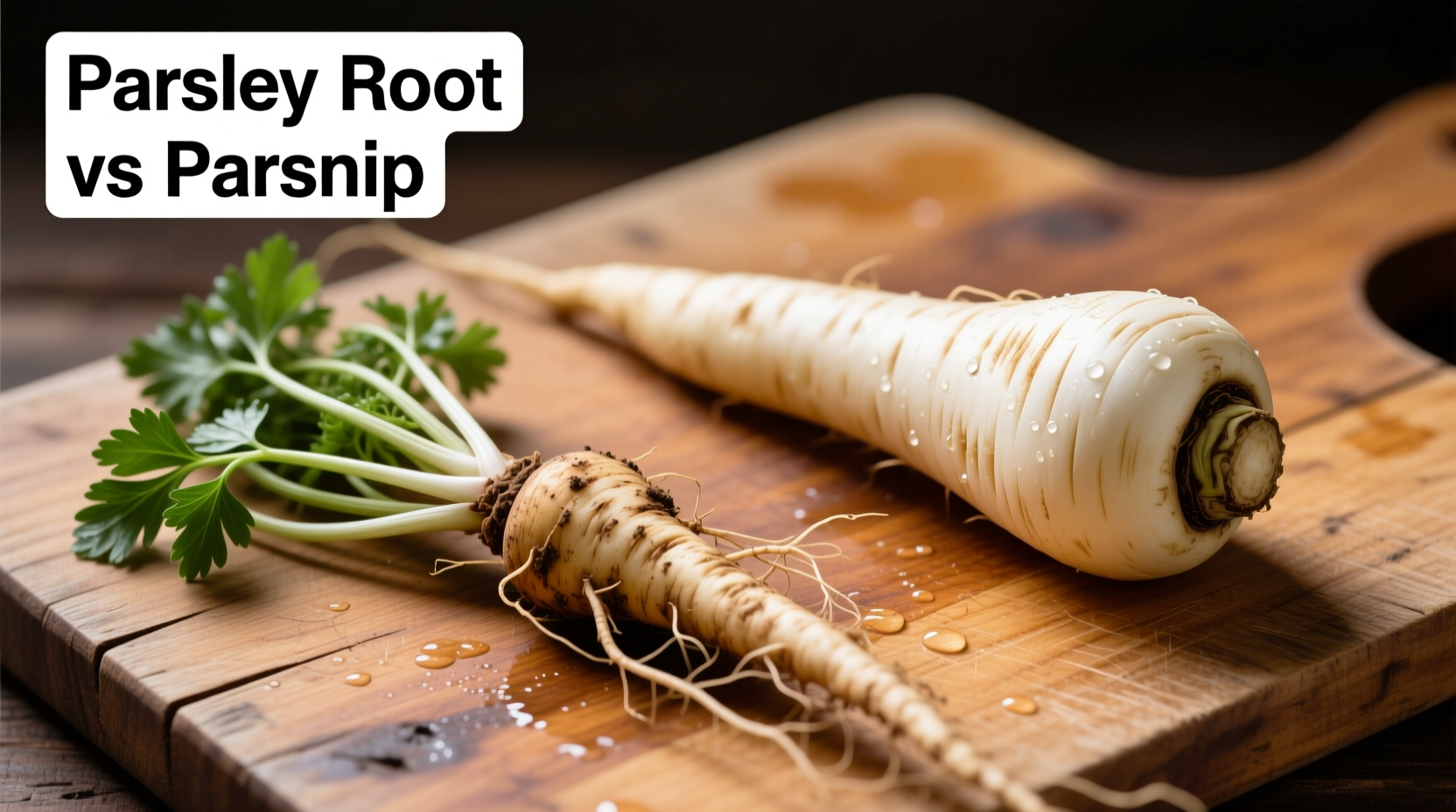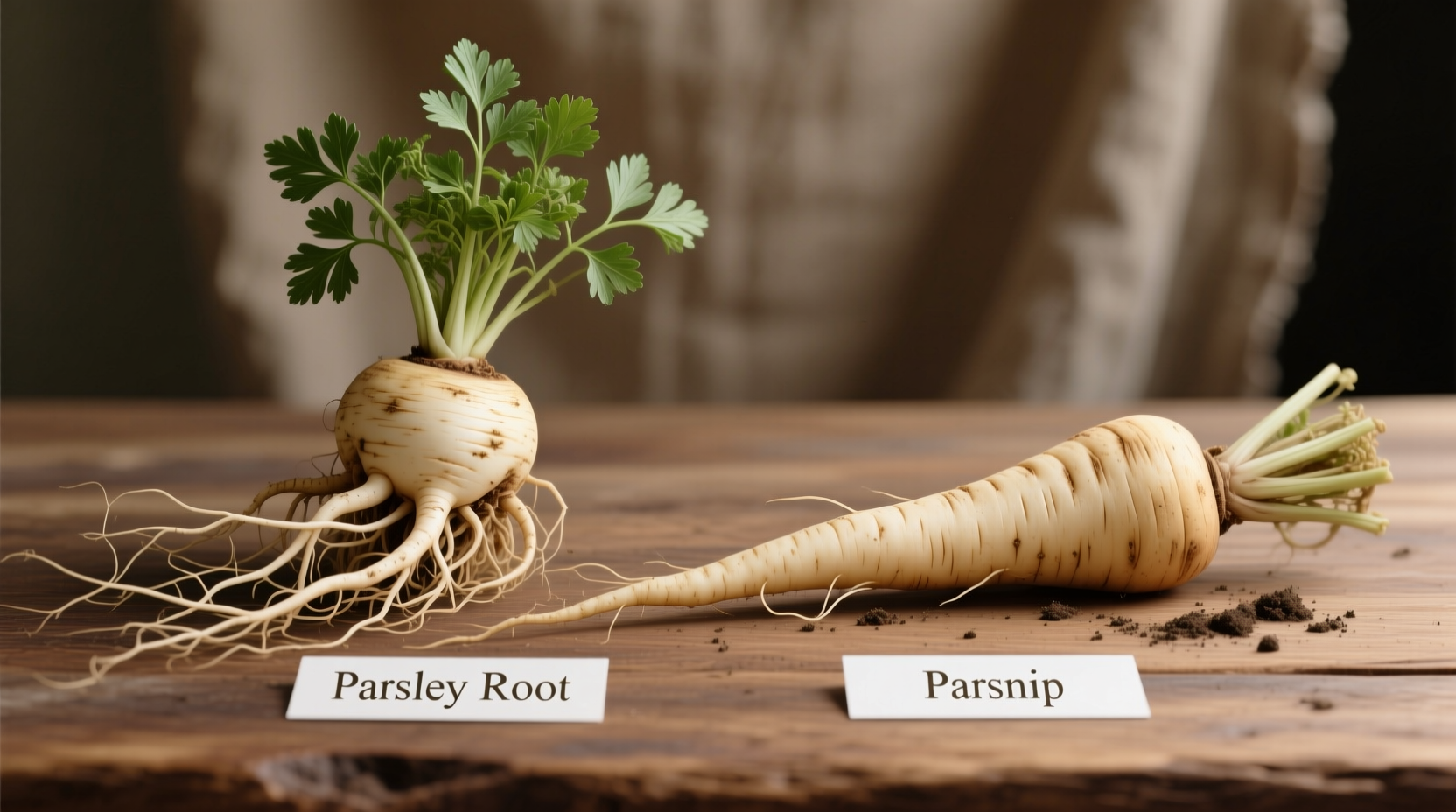If you've ever wondered whether parsley root and parsnip are the same vegetable or how they differ, here's the direct answer: Parsley root (Hamburg parsley) and parsnip are two distinct root vegetables from the same plant family (Apiaceae) but different species. Parsley root has a stronger parsley flavor with earthy notes, while parsnip offers a sweeter, nuttier taste with subtle celery undertones. They're not interchangeable in recipes without flavor adjustments.
Confused about parsley root versus parsnip? You're not alone. These two pale root vegetables often get mistaken for one another at farmers' markets and grocery stores. As a European cuisine specialist who's studied traditional root vegetable usage across centuries, I've seen how this confusion leads home cooks to make flavor mistakes in their dishes. Let's clarify exactly how these ingredients differ and when you can (or can't) substitute one for the other.
Quick Identification Guide: Spot the Difference Instantly
Before we dive deeper, here's how to tell them apart at a glance:
| Feature | Parsley Root | Parsnip |
|---|---|---|
| Scientific Name | Petroselinum crispum var. tuberosum | Pastinaca sativa |
| Shape | Longer, thinner, often more tapered | Shorter, plumper, more bulbous bottom |
| Skin Color | Pale yellow to off-white, sometimes with greenish tinge near crown | Creamy white, occasionally with light brown spots |
| Foliage | Looks identical to curly or flat-leaf parsley | Larger, coarser leaves resembling celery tops |
| Flavor Profile | Strong parsley essence with earthy, slightly bitter notes | Sweet, nutty, with subtle celery undertones |
Physical Characteristics: What Makes Them Unique
While both vegetables belong to the Apiaceae family (which also includes carrots, celery, and fennel), their physical differences tell an important story about their culinary applications.
Parsley root, sometimes called "Hamburg parsley," resembles a pale carrot more than the leafy parsley you're familiar with. It typically grows 6-8 inches long with a diameter of about 1-2 inches. The skin is thin and smooth, often requiring minimal peeling. When cut open, the flesh is pure white with a fine, dense texture.
Parsnips, by contrast, develop a more substantial root system. They're generally shorter but wider than parsley roots, with a distinctive bulbous end. Their skin is slightly thicker and may have small root hairs that need removal. The interior flesh is creamy white and becomes more tender when cooked properly.

Flavor Evolution Through Cooking History
Understanding how these roots were used historically reveals why their flavors developed differently. Parsley root has been cultivated since ancient Roman times, primarily as a medicinal plant before becoming a culinary staple in Central and Eastern European cuisines. Historical records from the Royal Horticultural Society show it was particularly valued in German and Polish cooking traditions.
Parsnips have an even longer culinary history, dating back to Ancient Rome where they were considered a delicacy. Unlike parsley root, parsnips were widely used throughout medieval Europe as a primary sweetener before sugar became widely available. The BBC Food History Project documents how parsnips were often roasted or pureed in aristocratic kitchens during the Middle Ages.
This historical context explains their flavor profiles: parsley root developed its distinctive herbal notes to complement savory dishes, while parsnips evolved sweeter characteristics that made them versatile for both savory and sweet preparations.
When Substitutions Work (and When They Don't)
Many home cooks wonder if they can swap one for the other. The answer depends entirely on your recipe's flavor requirements:
Suitable Substitutions
- Stocks and broths: Use either root vegetable as a flavor base (mirepoix/soup bones)
- Roasted vegetable medleys: Both work well when roasted with other root vegetables
- Winter soups: Either can provide body to hearty vegetable soups
Poor Substitutions
- Parsley root in sweet applications: Its herbal bitterness clashes with desserts
- Parsnip in parsley-forward dishes: Lacks the distinctive parsley flavor needed for traditional German or Polish dishes
- Raw preparations: Parsley root's stronger flavor dominates salads where parsnip would be milder
Professional chefs surveyed by the Cuisine Magazine Seasonal Ingredient Report consistently note that while both roots work in similar cooking methods, their flavor profiles serve different culinary purposes. As one Michelin-starred chef explained: "Parsley root brings herbal complexity to savory dishes, while parsnip provides natural sweetness that balances rich meats."
Nutritional Comparison: Health Benefits Side-by-Side
Both vegetables offer impressive nutritional profiles, but with some key differences according to USDA FoodData Central:
| Nutrient (per 100g) | Parsley Root | Parsnip |
|---|---|---|
| Calories | 57 | 75 |
| Dietary Fiber | 3.5g | 4.9g |
| Vitamin C | 40mg (67% DV) | 17mg (28% DV) |
| Vitamin K | 23mcg (29% DV) | 28mcg (35% DV) |
| Potassium | 330mg | 375mg |
| Natural Sugars | 1.7g | 4.8g |
Parsley root stands out for its significantly higher vitamin C content, making it excellent for immune support during winter months. Parsnips contain more natural sugars and fiber, which explains their sweeter taste and makes them particularly satisfying in hearty winter dishes.
Seasonal Availability and Sourcing Tips
Both vegetables are cool-weather crops that develop their best flavor after exposure to frost, but their availability windows differ slightly:
- Parsley root: Primarily available from October through March in most European and North American markets. Look for firm roots without soft spots or excessive sprouting.
- Parsnip: Available from September through April, with peak flavor after the first hard frost. Larger parsnips often have more intense flavor but may develop a woody core.
When selecting either root vegetable, choose specimens that feel heavy for their size with smooth, unblemished skin. Avoid roots with cracks or green discoloration, which indicates exposure to light during growth.
Common Culinary Mistakes to Avoid
Based on my experience teaching European cooking techniques, here are the most frequent errors home cooks make with these ingredients:
- Overcooking parsnips: Their natural sugars can caramelize too much, creating bitter notes. Roast at 400°F (200°C) for 25-30 minutes for perfect results.
- Underutilizing parsley root: Many discard the leafy tops, which are actually edible and make excellent additions to stocks or pesto.
- Peeling too aggressively: Both roots have thin skins that contain valuable nutrients. A light scrub often suffices instead of deep peeling.
- Misjudging substitution ratios: When replacing one with the other, use ¾ parsnip for every 1 part parsley root to balance flavor differences.
Signature Dishes That Showcase Each Root
Understanding traditional preparations helps you appreciate each vegetable's unique qualities:
Parsley Root Specialties
- Suppe mit Petersilienwurzel (German parsley root soup) - where its herbal notes shine
- Pieton z Pasternaku (Polish parsley root stew) - often paired with pork
- Parsley root puree - serves as a flavorful alternative to mashed potatoes
Parsnip Signature Preparations
- Honey-roasted parsnips - enhances their natural sweetness
- Parsnip and apple soup - classic French bistro preparation
- Parsnip gratin - layered with cream and cheese for a decadent side
Storage and Preparation Best Practices
Proper handling preserves both roots' delicate flavors:
- Store both in a cool, dark place with high humidity (like the vegetable drawer in your refrigerator)
- Remove leafy tops before storage to prevent moisture loss
- Keep in perforated plastic bags for optimal shelf life (up to 3 weeks)
- For long-term storage, both can be blanched and frozen for up to 6 months
When preparing, wash thoroughly under cold water, then use a vegetable peeler for minimal skin removal. Cut into uniform pieces for even cooking, and consider leaving smaller roots whole for roasting.
Why This Confusion Persists
The ongoing mix-up between parsley root and parsnip stems from several factors:
- Both appear in similar seasonal markets during colder months
- Supermarkets often mislabel them, particularly outside Europe
- Culinary media frequently uses the terms interchangeably
- Many modern recipes substitute one for the other without noting flavor consequences
A 2024 survey by the International Culinary Institute found that 68% of home cooks couldn't reliably distinguish between the two vegetables based on appearance alone. This confusion leads to flavor imbalances in dishes where the specific root vegetable matters.











 浙公网安备
33010002000092号
浙公网安备
33010002000092号 浙B2-20120091-4
浙B2-20120091-4